
|
|||
|
Jeep FAQ How-To Articles Quick Reference Product Reviews My Buildup Random Home |
Well after find a lack of CB antenna tuning write-ups, I figured I'd write one. The biggest problems I came across was what I did find was a whole bunch of in depth theory, that was rather dry. I don't want to spend days researching this, I just want to tune my CB antenna. This is meant to be a very basic, simple guide to tuning your CB antenna. Any antenna designed to transmit has to be tuned. Failure to tune your CB antenna will result in burning up your CB. Basically if your antenna is not tuned, some of your CB's signal will be reflected back into the radio, if this happens in very short order your CB will be receive only. To tune your CB antenna you will need a SWR Meter. Just in case you are wondering, SWR stands for Standing Wave Ratio. For this article I will be using Radio Shack's SWR meter, catalog number 21-534. I'm using this as it's a cheap meter that you can easily be picked up normally at any Radio Shack.  First thing to do is mount the antenna. Ideally you want at least half the antenna above the roof line, however, this really isn't possible without it being stupid high, and will get hit on everything. Best thing to do is get more than a 1 foot above the roof line for optimum results. It is very important that your antenna mount be grounded very well. Remember things like tailgate hinges don't make good grounds, so if you mount it on your tailgate you may need a grounding strap. I modified my factory spare tire stop to mount the antenna. 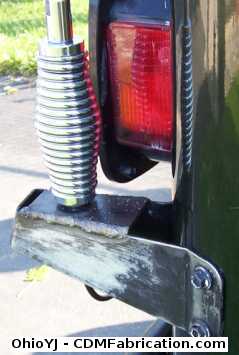 Notice in the picture everything is still bare metal. Make sure you antenna mount touches bare metal so it is properly grounded. After I mounted the antenna I taped it off and painted it. Magnet mount antennas are grounded differently; this will be discussed later in this article. Next the coax needs to be run. Every attempt should be made to keep the coax from being bent very sharply, or being pinched. Most will recommend you stay away from Radio Shack coax cable. Try and decide ahead of time how you will run the coax, as you want just enough cable, as coiling up an extra long cable isn't the best of ideas. Personally I bought some quality coax from a surplus store, along with ends, and soldered them on. Whether you make your own cable or buy one, it's still important to double check the coax to make sure it doesn't have any bad spots, or is shorted. This does two things, ensures you cable is in good condition and protects the radio from a shorted antenna cable which can result in burning up the CB. You'll need a multi-meter for this, set on ohms, to measure resistance. First on the antenna cable, check the center conductor, you should have very little or no resistance. If you have high resistance something is wrong with the cable and it should not be used. Could be the solder job, could be a faulty cable. 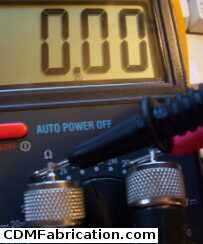 Next check the outer half of the antenna cable. 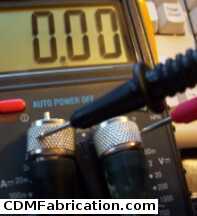 Again, high resistance is a bad sign. Should be zero or very little. Then just for good measure, go ahead and check the center conductor and the outer ring, the meter should read infinity, there should be no continuity here. 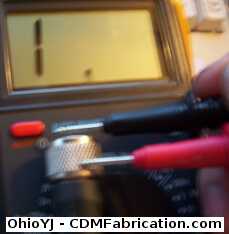 Ok if your cable checks good, go ahead and run it, you want it to be in its final position before you tune the antenna. On my Jeep I have the cable zip-tied (gently) to the roll bar over to the CB. Now you're going have to find a big open field, or parking lot. When you tune your CB antenna you don't want any houses, power lines, trees, etc, around. Any kind of building or obstruction can affect the SWR reading. I made this mistake, and tuned my CB radio next to some houses and everything looked good. Then I doubled check it in a field and all the sudden it was off the charts, and not safe to use. The SWR Meter goes in between the radio and the antenna. You'll need a short piece of coax to go from the meter to the radio, and then plug the antenna to the back of the SWR meter. 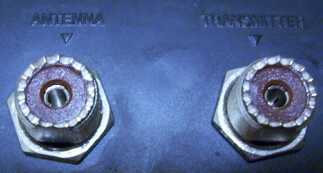 Most people will use all 40 channels on the CB from time to time, so it's a good idea to keep this in mind when tuning the antenna. The first thing you need to do is calibrate the SWR Meter. Again I'm using Radio Shacks SWR meter. On this meter, the switches should be on 200W, CAL, and PEP, just as the picture shows. Next turn on the CB and set it on channel 19. Then push the mic button, the needle should jump into the red, turn the calibration knob until the needle lines up with the line the blue arrow is pointing too.  Assuming you are going to use all 40 channels, the mid point, channel 19 should be the lowest, if you graphed the SWR figures, on an ideal setup they would look sort of like this. 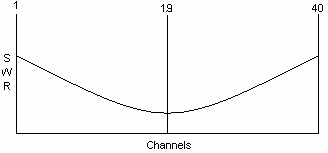 Time to see how close, or how far off your antenna is. Move the switch on the SWR meter from CAL to SWR. Switch to channel 1, key the mic, and note the reading, don't hold the mic button too long. Then switch to channel 40 and again note the reading. My Channel 1 SWR, 1.1 : 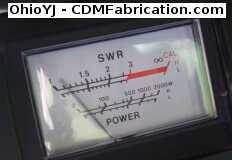 My Channel 40 SWR, 1.7 : 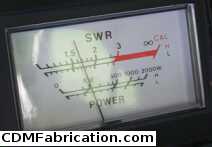 Somehow I got lucky, mine was safe to use from the start, however, tuning the antenna is easy, so I might as well adjust it some. I'm using a standard fiberglass whip antenna. With this antenna, there is a rubber cap on top of it:  Once this cap is removed, a flat head adjustment screw is visible in the end of the antenna.  If your SWR is greater on 40 than it is on 1, your antenna is long. If your SWR is greater on 1 than it is on 40, your antenna is short. My SWR was higher on 40 than 1, so I know it's long. I made my initial adjustments by turning the adjustment screw a full turn, then once I got close I turned it half turns. Remember to replace the little cap every time, as the SWR will be different with and without the cap. Also remember when check the SWR meter, make sure to close the doors and such, you want to replicate actual conditions that the radio will be used in. Keep flipping back and forth between 1 and 40. I kept going until I got 1 and 40 identical, and then 19 was the lowest SWR reading, just like the graph above. Sometimes this is not possible, but anything below 2.0 is safe to use. The lower you get the more efficient your radio will be, meaning it will have a greater range. Once you think you got it, check various other random channels, and make sure you don't have any weird spikes, if everything is less than 2.0 you?re good to go. My highest SWR ended up being 1.3, not to shabby. Magnet mount antennas aren't the best route, but they will work. Basically make sure you stick it somewhere so the antenna still sticks above the roof line some. Most magnet mount antennas are adjusted by actually raising or lowering the antenna in the mount. 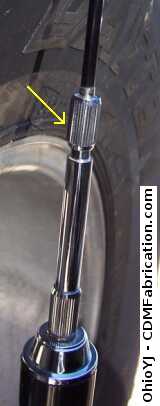 The antenna above is adjusted my loosening the lock at the top, then the antenna can be raised or lowered accordingly. While tuning this magnet mount antenna, I had less than optimal results, but it was still safe to use, the highest SWR was 2.0, at best it reached 1.5.
© Copyright 2006 - 2025 Mike Lee
|
|
|